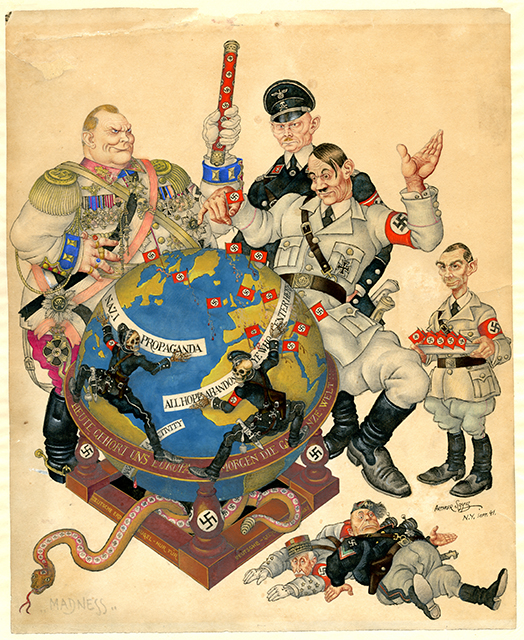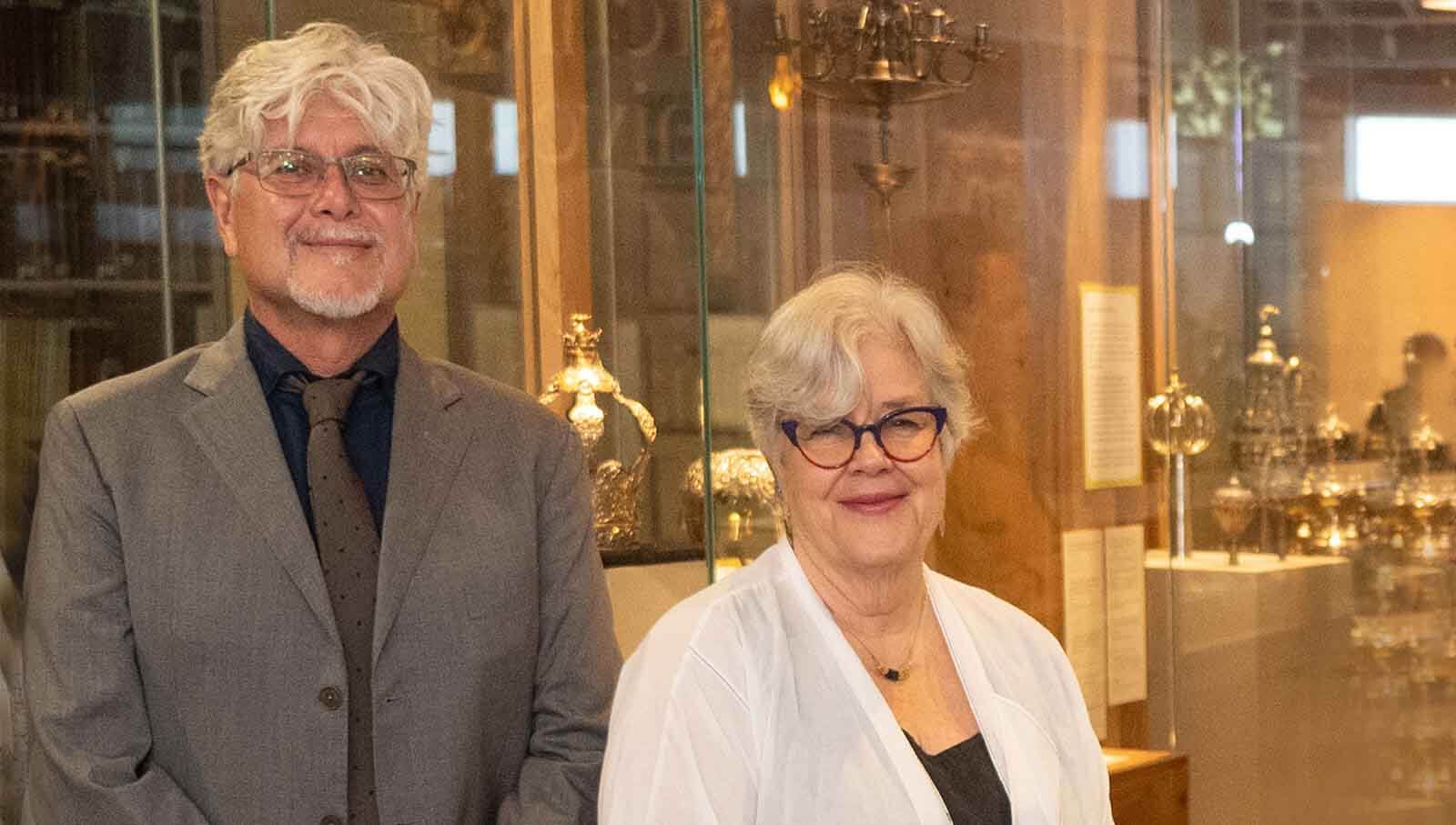News
Press Release | Exhibition of Political Art by WWII-Era Human Rights Advocate Arthur Szyk Opens at UC Berkeley Magnes Collection (1.21.2020)
January 21, 2020Exhibition of Political Art by WWII-Era Human Rights Advocate Arthur Szyk
Opens at UC Berkeley Magnes Collection
Students help to bring artist’s historic calls to action to contemporary audiences
Berkeley, Calif. (January 21, 2020)—Arthur Szyk’s compelling political cartoons placed Nazi genocide, tyranny and racism on the covers of America’s most popular magazines during World War II. Today, his pioneering examples of graphic storytelling have renewed relevance as a new exhibition and University of California, Berkeley students bring Szyk’s works to contemporary audiences.
In Real Times. Arthur Szyk: Art & Human Rights (1926-1951) will be open to the public January 28—May 29 and September 1—December 18, 2020 at The Magnes Collection of Jewish Art and Life at UC Berkeley. Uniquely through art, Szyk was one of the first public figures to take immediate, direct action in bringing attention to the Holocaust as it was being perpetrated. The miniature size of his artwork stands in striking juxtaposition to the magnitude of the themes it confronted and the human rights violations it exposed.
Made possible by a generous gift of the Szyk collection from Bay Area-based Taube Philanthropies, the new exhibition includes more than 50 original artworks by Szyk and features two interactive workstations created by UC Berkeley students and Francesco Spagnolo, The Magnes curator.
Spagnolo has supervised nearly 100 students working at The Magnes over the past three years through UC Berkeley’s Undergraduate Research Apprentice Program. “It’s a diverse group of students—some with Jewish backgrounds and some with no connection to Judaism. Szyk’s work speaks to their shared concerns about human rights.”
Miniatures Through a New Lens
UC Berkeley students digitized the entire Taube Family Arthur Szyk Collection of more than 450 pieces for the workstation titled “The Artist’s Gaze, Through a Digital Lens,” which presents each work of art in a high-resolution slideshow. Szyk used motifs drawn from the Bible, history, politics and culture to create searing artistic commentary. He addressed a diverse range of subjects including the U.S. War of Independence, the Holocaust, World War II and the Ku Klux Klan. Visitors can pause the slideshow and zoom in on any image to reveal unexpected details and extraordinary craftsmanship.
For the “Arthur Szyk, Remixed” workstation, students deconstructed more than 50 of Szyk’s works to encourage visitors to examine the characters and motifs individually and then recombine them to make their own political cartoons. New creations can be saved and instantly published online, giving Szyk’s compelling art an even wider audience. The screens of both workstation tablets are projected onto the walls of the gallery for all to see.
“Sharing Szyk’s art with younger generations and inspiring them to defend personal dignity, identity and freedom is an important part of Taube Philanthropies’ work to effect positive change in our world,” said Tad Taube, chairman of Taube Philanthropies.
A Legacy of Civic Engagement
The new exhibition displays more than 50 original pieces of Szyk’s work created between 1926 and 1951. The works are organized into six sections focused on various aspects of human rights:
- Human Rights and their Collapse is an introduction to Szyk’s world with a timeline showing his life in the context of the progressive failure of European democracies and the human rights and national rights movements, beginning with the American Revolution. Here, a selection of Syzk’s works begin to show his lifelong focus on freedom and the dangers of tyranny and totalitarianism.
- The Rights of Global Refugees shows Szyk’s deep concern for refugees like himself and their lack of the legal protections of citizenship. This section features depictions of refugees in many contexts, from cartoons of innocent children declared enemies of Third Reich to biblical narratives and a self-portrait included in Szyk’s ode to Canada.
- The Right to Resist highlights the role of resistance in preserving human rights with Szyk’s paintings of the Warsaw Ghetto uprising and his internationally acclaimed illustration of “The Statute of Kalisz.” The statute, which granted Jews legal rights and liberties in Poland in medieval times, was displayed in London in 1933 to denounce antisemitism in Nazi Germany.
- The Rights of Nationhood further explores Szyk’s belief that human rights are inextricably tied to citizenship, featuring designs he created for countries and organizations. These detailed illustrations became letterheads and stamps and often found their way into his political cartoons.
- The Right to Expose: Executioners at Work displays many of Szyk’s most powerful pieces, which depicted the crimes of Axis leaders and Nazis during the Holocaust. This portion of the exhibition also explores an interesting parallel to Charlie Chaplin’s characters in his 1940 movie, The Great Dictator.
- The Right to America highlights Szyk’s appreciation of his new home country and the multi-ethnic fabric of the U.S. Army, positioning it in direct contrast to Nazi Aryan supremacy. The work in this section reflects Szyk’s objection to racial discrimination and the organizations that perpetuate it, such as the Ku Klux Klan.
Szyk’s Background and Path to The Magnes
Born into a middle-class Polish Jewish family in 1894, Arthur Szyk led a life framed by two world wars, the rise of totalitarianism in Europe, and the birth of the State of Israel, before his death in 1951. Much of his work centered around these historical experiences. Szyk was raised in Poland, educated in France, traveled to the Middle East and North Africa, and lived in London and Canada before moving to New York in 1940. There he met members of the Taube family who, like Szyk, were emigres. The relationship Szyk developed with the Taube family and the humanitarian lessons embedded in Szyk’s art spurred Tad Taube to ensure the preservation of his oeuvre.
More than 450 pieces of Szyk’s work were moved from a private collection to The Magnes at UC Berkeley in 2017 as a result of a $10.1 million gift from Taube Philanthropies, becoming The Taube Family Arthur Szyk Collection. The gift was the largest single monetary gift to acquire art in the history of the university. An appropriate home for Szyk’s work, The Magnes holds the third-largest Jewish museum collection in the U.S., and the only one of such size in the world housed at a research university.
“Working in the arts, I know what a tremendous rarity it is that the canon of an artist’s work be maintained and protected for future generations,” said Szyk’s great-granddaughter Danielle Mosse, a vice president at Christie’s, the famed art auction house in New York. “Thanks to Taube Philanthropies and The Magnes, Szyk’s legacy as an artist, champion of Polish and Jewish life, and soldier against injustice is secured for generations to come.”
High-resolution images of Szyk’s artwork presented in In Real Times. Arthur Szyk: Art & Human Rights (1926-1951) are available for use by the media, with captions, here: https://bit.ly/2FxFwtD
About The Magnes Collection of Jewish Art and Life, UC Berkeley
The Magnes Collection of Jewish Art and Life was established in 2010 following the transfer of the Judah L. Magnes Museum to the University of California, Berkeley. Its remarkably diverse archive, library and museum holdings include art, objects, texts, music and historical documents about the Jews in the global diaspora and the American West. As one of the world’s preeminent Jewish collections in a university setting, it provides highly innovative and accessible resources to both researchers the general public.
About Taube Philanthropies
For more than 30 years, Taube Philanthropies has been a leader in supporting diverse educational, research, cultural, community and youth organizations in the San Francisco Bay Area, Poland and Israel. Founded by businessman and philanthropist Tad Taube in 1981, and now led by Tad and his wife Dianne Taube, the organization works to ensure that citizens have the freedom and opportunity for advancement of their goals and dreams. taubephilanthropies.org
Press Contact:
Tami Kelly, Brazer Communications
tami@brazercommunications.com
925-640-9997
Press Release | Exhibition … by magnesmuseum on Scribd
Latest News
Keep Up-To-Date





